1000+ Cell - the unit of life Multiple Choice Question Answer [Solved]
Thursday 9th of March 2023

Sharing is caring
1. Which one of the following organelle given below is correctly matched with its function ?
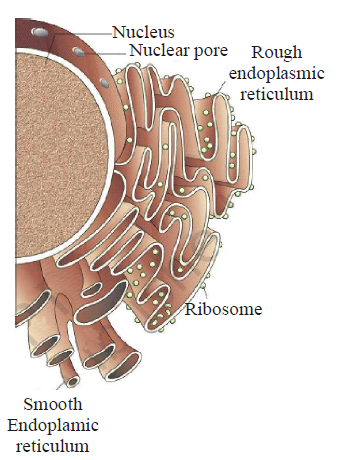
A. Golgi apparatus Protein synthesis
B. Golgi apparatus Formation of glycolipids
C. Rough endoplasmic reticulum Protein synthesis
D. Rough endoplasmic reticulum Formation of glycoproteins
Answer : C

A. Golgi apparatus Protein synthesis
B. Golgi apparatus Formation of glycolipids
C. Rough endoplasmic reticulum Protein synthesis
D. Rough endoplasmic reticulum Formation of glycoproteins
Answer : C
2. The given diagram shows the types of chromosomes (labelled as A, B, C & D) based on the position of centromere.
Which one is the correct option for the labelled chromosomes. A, B, C and D ?

A. A Telocentric chromosome, B Acrocentric chromosome, C Submetacentric chromosome, D Metacentric chromosome
B. A Acrocentric chromosome, B Telocentric chromosome, C Metacentric chromosome, D Submetacentric chromosome
C. A Submetacentric chromosome, B Metacentric chromosome, C Telocentric chromosome, D Acrocentric chromosome
D. A Metacentric chromosome, B Submetacentric chromosome, C Acrocentric chromosome, D Telocentric chromosome.
Answer : A
Which one is the correct option for the labelled chromosomes. A, B, C and D ?

A. A Telocentric chromosome, B Acrocentric chromosome, C Submetacentric chromosome, D Metacentric chromosome
B. A Acrocentric chromosome, B Telocentric chromosome, C Metacentric chromosome, D Submetacentric chromosome
C. A Submetacentric chromosome, B Metacentric chromosome, C Telocentric chromosome, D Acrocentric chromosome
D. A Metacentric chromosome, B Submetacentric chromosome, C Acrocentric chromosome, D Telocentric chromosome.
Answer : A
3. Difference between the prokaryotic and eukaryotic cells in having
A. cell wall
B. nuclear membrane
C. ribosome
D. none of these
Answer : B
A. cell wall
B. nuclear membrane
C. ribosome
D. none of these
Answer : B
4. pH of vacuolar cell sap is
A. neutral and isotonic.
B. alkaline and isotonic.
C. acidic and hypertonic.
D. equal to cytoplasm and isotonic.
Answer : C
A. neutral and isotonic.
B. alkaline and isotonic.
C. acidic and hypertonic.
D. equal to cytoplasm and isotonic.
Answer : C
5. Prokaryotic and eukaryotic flagella differ in the
A. type of movement and placement.
B. location and mode of functioning.
C. microtubular structure and function.
D. microtubular organization and type of movement.
Answer : D
A. type of movement and placement.
B. location and mode of functioning.
C. microtubular structure and function.
D. microtubular organization and type of movement.
Answer : D
6. 9.A student was given cell samples (A and B) to identify parts which are highlighted. He observed the samples under the microscope and list down the function of the part of cell sample. The information collected by the student is listed in the table below, on the basis of which the student infers that the samples contain the organelles.
Explain why the samples were belonged to eukaryotic cell and not prokaryotic cell? Because,
A. eukaryotic cell have membrane bound organelles.
B. eukaryotic cell have non - membrane bound organelles.
C. eukaryotic cell are smaller and multiply more rapidly than prokaryotic cells.
D. eukaryotic cell are larger and multiply more rapidly than prokaryotic cells.
Answer : B
| Sample A | Sample B |
|---|---|
| Make energy available for cellular metabolism | Generates ATP and synthes izes s ugar |
| Absent in cell that carry oxygen throughout the body | Present in plant cell |
| Called the energy currency of cell | Source o f all the food energy |
Explain why the samples were belonged to eukaryotic cell and not prokaryotic cell? Because,
A. eukaryotic cell have membrane bound organelles.
B. eukaryotic cell have non - membrane bound organelles.
C. eukaryotic cell are smaller and multiply more rapidly than prokaryotic cells.
D. eukaryotic cell are larger and multiply more rapidly than prokaryotic cells.
Answer : B
7. A student placed two cells in the same solution in two different containers. The observation was given in the table.
Which structure maintains the shape of the cell present in container 2 and provides the most significant difference between the two cells?
A. Nucleus
B. Cell wall
C. Chloroplast
D. Cell membrane
Answer : B
| Container | Observation |
|---|---|
| 1 | Cell burst |
| 2 | Cell does not change its shape |
Which structure maintains the shape of the cell present in container 2 and provides the most significant difference between the two cells?
A. Nucleus
B. Cell wall
C. Chloroplast
D. Cell membrane
Answer : B
8. Match column-I and column-II and select the correct answer
A. A III; B IV; C II; D I
B. A II; B IV; C III; D I
C. A I; B II; C III; D IV
D. A IV; B III; C I ; D II
Answer : B
| Column-I | Column-II |
|---|---|
| A. Bacteria without walls | I. Lysosome |
| B. Small circular DNA | II. Mycoplasma cells |
| C. Flattened sacs in | III. Thylakoid a chloroplast |
| D. A vesicle in which | IV. Plasmid hydrolytic enzymes are stored |
A. A III; B IV; C II; D I
B. A II; B IV; C III; D I
C. A I; B II; C III; D IV
D. A IV; B III; C I ; D II
Answer : B
9. Which of the following statement is false?
A. The ribosomes of a polysome translate the mRNA into protein.
B. Mitochondria divide by fragmentation.
C. All cell arise from pre-existing cells.
D. The lipid component of the membrane mainly consists of phosphoglycerides.
Answer : B
A. The ribosomes of a polysome translate the mRNA into protein.
B. Mitochondria divide by fragmentation.
C. All cell arise from pre-existing cells.
D. The lipid component of the membrane mainly consists of phosphoglycerides.
Answer : B
10. According to widely accepted fluid mosaic model cell membranes are semi-fluid, where lipids and integral proteins can diffuse randomly. In recent years, this model has been modified in several respects. In this regard, which of the following statements is incorrect?
A. Proteins in cell membranes can travel within the lipid bilayer.
B. Proteins can also undergo flip-flop movements in the lipid bilayer.
C. Proteins can remain confined within certain domains of the membrane.
D. Many proteins remain completely embedded within the lipid bilayer.
Answer : B
A. Proteins in cell membranes can travel within the lipid bilayer.
B. Proteins can also undergo flip-flop movements in the lipid bilayer.
C. Proteins can remain confined within certain domains of the membrane.
D. Many proteins remain completely embedded within the lipid bilayer.
Answer : B
11. The best way to identify a cell as either prokaryotic or eukaryotic is to determine whether
A. it came from a single-celled or multicellular organism.
B. it has a nucleus.
C. it has a plasma membrane.
D. it has cytosol.
Answer : A
A. it came from a single-celled or multicellular organism.
B. it has a nucleus.
C. it has a plasma membrane.
D. it has cytosol.
Answer : A
12. The diagram given below represent a filuid mosaic model of plasma membrance. Match the components marked as A, B, C, D and E in the diagram below from the list (i) to (vii).
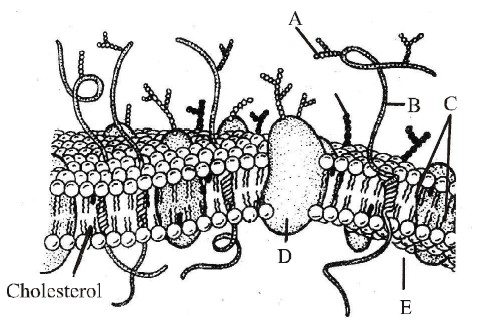
A. A - (i), B - (ii), C - (iii), D - (iv), E - (v)
B. A - (ii), B - (i), C - (iii), D - (iv), E - (v)
C. A - (i), B - (ii), C - (iii), D - (iv), E - (vi)
D. A - (i), B - (ii), C - (iii), D - (vii), E - (v)
Answer : A

- Sugar
- Protein
- Lipid bilayer
- Integral protein
- Cytoplasm
- Cell wall
- External protein
A. A - (i), B - (ii), C - (iii), D - (iv), E - (v)
B. A - (ii), B - (i), C - (iii), D - (iv), E - (v)
C. A - (i), B - (ii), C - (iii), D - (iv), E - (vi)
D. A - (i), B - (ii), C - (iii), D - (vii), E - (v)
Answer : A
13. Which of the followingstatements are correct?
A. Na+/K+ pump is an example of active transport.
B. In plant cells lipid like steroidal hormones are synthesized in SER.
C. In plant cells, the vacuoles can occupy up to 10% of the volume of the cell.
D. Chlorophyll and leucoplast are responsible for trapping light energy essential for photosynthesis.
Answer : A
A. Na+/K+ pump is an example of active transport.
B. In plant cells lipid like steroidal hormones are synthesized in SER.
C. In plant cells, the vacuoles can occupy up to 10% of the volume of the cell.
D. Chlorophyll and leucoplast are responsible for trapping light energy essential for photosynthesis.
Answer : A
14. Identify the components labelled as A, B, C, D and E in the diagram given below from the list (i) to (viii).
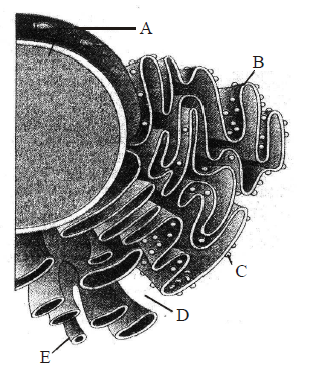
A. A - (viii), B - (v), C - (vii), D - (iii), E - (iv)
B. A - (i), B - (iv), C - (vii), D - (vi), E - (iii)
C. A - (vi), B - (v), C - (iv), D - (vii), E - (i)
D. A - (v), B - (i), C - (iii), D - (ii), E - (iv)
Answer : A

- Cristae of mitochondria
- Inner membrane of mitochondria
- Cytoplasm
- Smooth endoplasmic reticulum
- Rough endoplasmic reticulum
- Mitochondrial matrix
- Ribosome
- Nucleus
A. A - (viii), B - (v), C - (vii), D - (iii), E - (iv)
B. A - (i), B - (iv), C - (vii), D - (vi), E - (iii)
C. A - (vi), B - (v), C - (iv), D - (vii), E - (i)
D. A - (v), B - (i), C - (iii), D - (ii), E - (iv)
Answer : A
15. The cell theory was given in year 1839 by Schleiden and Schwann. According to this theory all organisms are composed of cell and cells are the basic unit of life.
How did this theory help in the field of science?
A. It helped to study the working of cells.
B. It helped in curing diseases caused by cell.
C. It helped in restating the earlier theories on cell.
D. It helped in introducing the use of microscopes to study cell.
Answer : A
How did this theory help in the field of science?
A. It helped to study the working of cells.
B. It helped in curing diseases caused by cell.
C. It helped in restating the earlier theories on cell.
D. It helped in introducing the use of microscopes to study cell.
Answer : A
16. Which of the following statements are incorrect ?
A. (i) and (iii)
B. (iii) and (iv)
C. (ii) and (iv)
D. (i) and (iv)
Answer : A
- Plant cells have centrioles which are absent in almost all animal cells.
- Ribosomes are the site of protein synthesis.
- The middle lamella is a layer mainly of calcium carbonate which holds the different neighbouring cells together.
- In animal cell, steroidal hormones are synthesized by smooth endoplasmic reticulum. Of the above statements
A. (i) and (iii)
B. (iii) and (iv)
C. (ii) and (iv)
D. (i) and (iv)
Answer : A
17. You are asked to examine a cell using a powerful light microscope. The image you see has a clearly defined nucleus and mitochondria. It also has a large central vacuole and chloroplasts. From what group of organisms did this cell most likely come?
A. Bacteria
B. Protists
C. Fungi
D. Plants
Answer : D
A. Bacteria
B. Protists
C. Fungi
D. Plants
Answer : D
18. Function of contractile vacuole in Amoeba is
A. excretion and osmoregulation.
B. digestion and respiration.
C. osmoregulation and transportation.
D. none of the above.
Answer : A
A. excretion and osmoregulation.
B. digestion and respiration.
C. osmoregulation and transportation.
D. none of the above.
Answer : A
19. Golgi apparatus is absent in
A. higher plants
B. yeast
C. bacteria and blue-green algae
D. None of the above
Answer : C
A. higher plants
B. yeast
C. bacteria and blue-green algae
D. None of the above
Answer : C
20. Active transport differs from passive transport in that active transport
A. requires energy.
B. always requires input of ATP.
C. moves molecules against a concentration gradient.
D. both (a) and (c)
Answer : D
A. requires energy.
B. always requires input of ATP.
C. moves molecules against a concentration gradient.
D. both (a) and (c)
Answer : D
21. Grana are
A. protein storing plastids.
B. coloured plastids.
C. stacks of thylakoids.
D. individual thylakoids present in stroma.
Answer : C
A. protein storing plastids.
B. coloured plastids.
C. stacks of thylakoids.
D. individual thylakoids present in stroma.
Answer : C
22. What would happen if lysosomes get ruptured in a cell?
A. Cell dies
B. Cell shrinks
C. Cell swell up
D. Nothing would happen
Answer : A
A. Cell dies
B. Cell shrinks
C. Cell swell up
D. Nothing would happen
Answer : A
23. The given figures show two types of cell. Which structures are common to both the cells?

A. Nucleus and cell wall
B. Nucleus and cytoplasm
C. Ribosomes and flagella
D. Ribosomes and cell wall
Answer : D

A. Nucleus and cell wall
B. Nucleus and cytoplasm
C. Ribosomes and flagella
D. Ribosomes and cell wall
Answer : D
24. Which of the following statement is correct regarding vacuole?
A. It is membrane-bound and contains storage proteins and lipids.
B. It is membrane-bound and contains water and excretory substances.
C. It lacks membrane and contains air.
D. It lacks membrane and contains water and excretory substances.
Answer : B
A. It is membrane-bound and contains storage proteins and lipids.
B. It is membrane-bound and contains water and excretory substances.
C. It lacks membrane and contains air.
D. It lacks membrane and contains water and excretory substances.
Answer : B
25. Which of the following statement of a bacterial cell is/are correct?
A. (i), (ii), (iii)
B. All of the above
C. (ii) & (iv)
D. None of the above
Answer : A
- Mesosome is formed by the extensions of plasma membrane into the cell.
- The pili are elongated tubular structures made up of a protein.
- Flagellum is composed of filament, hook and basal body.
- Ribosomes are about 30 nm by 50 nm in size.
A. (i), (ii), (iii)
B. All of the above
C. (ii) & (iv)
D. None of the above
Answer : A
26. Which one of the following cellular parts is correctly matched with their characters ?
A. Centrioles Sites for active RNA synthesis.
B. Lysosomes Optimally active at a pH of about 8.5.
C. Thylakoids Flattened membranous sacs forming the grana of chloroplasts.
D. Ribosomes Those on chloroplasts are larger (80S) while those in the cytoplasm are smaller (70S).
Answer : C
A. Centrioles Sites for active RNA synthesis.
B. Lysosomes Optimally active at a pH of about 8.5.
C. Thylakoids Flattened membranous sacs forming the grana of chloroplasts.
D. Ribosomes Those on chloroplasts are larger (80S) while those in the cytoplasm are smaller (70S).
Answer : C
27. Membranous extensions in blue green algae are known as
A. phytochrome
B. chromatophore
C. mesosome
D. pneumatophore
Answer : B
A. phytochrome
B. chromatophore
C. mesosome
D. pneumatophore
Answer : B
28. Golgi apparatus is concerned with
A. excretion
B. secretion
C. ATP synthesis
D. RNA synthesis
Answer : A
A. excretion
B. secretion
C. ATP synthesis
D. RNA synthesis
Answer : A
29. Read the statements given below with regard to the functions performed by Golgi apparatus ?
Which of the following is the correct answer ?
A. (i) is wrong but (ii) and (iii) are correct
B. (ii) iswrong but (i) and (iii) are correct
C. (ii) and (iii) are wrong but (i) is correct
D. All are correct.
Answer : D
- Transport and chemically modify the materials contained within it.
- Performs the function of packaging materials.
- Important site of formation of glycoproteins and glycolipids.
Which of the following is the correct answer ?
A. (i) is wrong but (ii) and (iii) are correct
B. (ii) iswrong but (i) and (iii) are correct
C. (ii) and (iii) are wrong but (i) is correct
D. All are correct.
Answer : D
30. Read the folowing statements and identify the correct option.
A. (i) and (ii)
B. (ii) and (iv)
C. (i), (ii) and (iv)
D. None of the above
Answer : C
- Contractile vacuole takes part in osmoregulation and excretion.
- Food vacuole is formed by engulfing the food particles.
- The vacuole is bound by a double membrane called tonoplast.
- Vacuole can occupy upto 90 percent of the volume of the cell.
A. (i) and (ii)
B. (ii) and (iv)
C. (i), (ii) and (iv)
D. None of the above
Answer : C
31. Choose the incorrect match.
A. Nucleus RNA
B. Lysosome Protein synthesis
C. Mitochondria Respiration
D. Cytoskeleton Microtubules
Answer : B
A. Nucleus RNA
B. Lysosome Protein synthesis
C. Mitochondria Respiration
D. Cytoskeleton Microtubules
Answer : B
32. Cell sap is a
A. living content of cytoplasm.
B. nonliving content of cytoplasm.
C. nonliving content of vacuole.
D. living content of vacuole.
Answer : C
A. living content of cytoplasm.
B. nonliving content of cytoplasm.
C. nonliving content of vacuole.
D. living content of vacuole.
Answer : C
33. A component of cytoskeleton is
A. microtubule
B. bone
C. chitin
D. cartilage.
Answer : A
A. microtubule
B. bone
C. chitin
D. cartilage.
Answer : A
34. Which of the following is incorrect ?
A. Mycoplasma is the smallest cell (0.3 �).
B. Bacteria are 3 to 5 �m in size.
C. The largest cell is the egg of an ostrich.
D. Nerve cells are some of the smallest cells.
Answer : D
A. Mycoplasma is the smallest cell (0.3 �).
B. Bacteria are 3 to 5 �m in size.
C. The largest cell is the egg of an ostrich.
D. Nerve cells are some of the smallest cells.
Answer : D
35. Lysosomes contain
A. carbohydrates
B. hormones
C. nucleic acids
D. hydrolases.
Answer : D
A. carbohydrates
B. hormones
C. nucleic acids
D. hydrolases.
Answer : D
36. An organalle devoid of membrane covering is
A. vacuole
B. ribosome
C. peroxisome
D. lysosome
Answer : B
A. vacuole
B. ribosome
C. peroxisome
D. lysosome
Answer : B
37. Both the membranes of mitochondrion are
A. structurally different but functionally similar.
B. structurally as well as functionally different.
C. structurally similar but functionally different.
D. structurally different but functionally similar.
Answer : B
A. structurally different but functionally similar.
B. structurally as well as functionally different.
C. structurally similar but functionally different.
D. structurally different but functionally similar.
Answer : B
38. In which method of transport, plasma membrane does not require carrier molecule?
A. Active transport
B. Facilitated diffusion
C. Simple diffusion
D. Na+ K+ pump
Answer : C
A. Active transport
B. Facilitated diffusion
C. Simple diffusion
D. Na+ K+ pump
Answer : C
39. 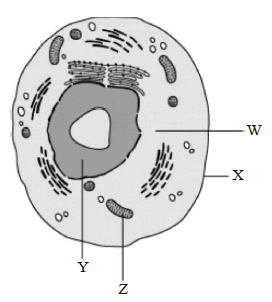
Which function is carried out by the cell organelle 'X'?
A. helps control the movement of substance in and out of the cell
B. passes information from the parent cell to newly formed cell
C. maintains the proper shape of the cell and serves as a protective barrier
D. helps the cell to make food with the help of chlorophyll and sunlight
Answer : A

Which function is carried out by the cell organelle 'X'?
A. helps control the movement of substance in and out of the cell
B. passes information from the parent cell to newly formed cell
C. maintains the proper shape of the cell and serves as a protective barrier
D. helps the cell to make food with the help of chlorophyll and sunlight
Answer : A
40. Polysome is a chain of
A. oxysomes
B. sphaerosomes
C. ribosomes
D. dictyosomes
Answer : C
A. oxysomes
B. sphaerosomes
C. ribosomes
D. dictyosomes
Answer : C
41. Match column-I (cell organelle) with column-II membrane and select the correct option from the codes given below.
A. A - I, B - II, C - III
B. A - III, B - I, C - II
C. A - III, B - II, C - I
D. A - II, B - III, C - I
Answer : C
| Column-I | Column-II |
|---|---|
| A. Mitochondria | I. Without membrane |
| B. Lysosomes | II. Single membrane |
| C. Ribosomes | III. Double membrane |
A. A - I, B - II, C - III
B. A - III, B - I, C - II
C. A - III, B - II, C - I
D. A - II, B - III, C - I
Answer : C
42. Which of these is wrongly matched?
A. Chloroplasts Chlorophyll
B. Elaioplasts Starch
C. Chromoplasts Carotenoids
D. Amyloplasts Carbohydrates
Answer : B
A. Chloroplasts Chlorophyll
B. Elaioplasts Starch
C. Chromoplasts Carotenoids
D. Amyloplasts Carbohydrates
Answer : B
43. Match column I (cell type) with column II (size) and choose the correct option.
A. A I, B II, C III, D IV
B. A IV, B III, C II, D I
C. A I, B III, C II, D IV
D. A IV, B II, C III, D I
Answer : B
| Column-I | Column-II |
|---|---|
| (Cell type) | (Size) |
| A. Viruses | I. 1-2 ??m |
| B. PPLO | II. 10-20 ??m |
| C. Eukaryotic cell | III. About 0.1 ??m |
| D. Bacterium | IV. 0.02 - 0.2 ??m |
A. A I, B II, C III, D IV
B. A IV, B III, C II, D I
C. A I, B III, C II, D IV
D. A IV, B II, C III, D I
Answer : B
44. Match column-I with column-II and select the correct option.
A. A III, B II, C IV, D I
B. A II, B III, C IV, D I
C. A I, B III, C II, D IV
D. A IV, B II, C III, D I
Answer : A
| Column - I | Column - II |
|---|---|
| A. RER | I. Intracellular and extracellular digestion |
| B. Cell wall | II. Provide structural support to the cell |
| C. Flagella | III. Protein synthesis and secretion |
| D. Lysosomes | IV Responsible for cell movement |
A. A III, B II, C IV, D I
B. A II, B III, C IV, D I
C. A I, B III, C II, D IV
D. A IV, B II, C III, D I
Answer : A
45. In the given figure of animal cell, one orginelle is marked as A. Select the correct identification and function of the organelle A from the given option.
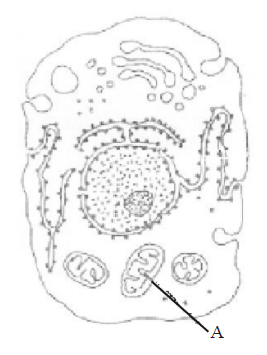
A. Endoplasmic reticulum Synthesis of lipids.
B. Mitochondria Produce cellular energy in the form of ATP.
C. Golgi body Provides packaging material.
D. Lysosomes Secrete hydrolytic enzymes.
Answer : B

A. Endoplasmic reticulum Synthesis of lipids.
B. Mitochondria Produce cellular energy in the form of ATP.
C. Golgi body Provides packaging material.
D. Lysosomes Secrete hydrolytic enzymes.
Answer : B
46. Chromosomes having equal or almost equal arms are called
A. metacentric
B. acrocentric
C. polycentric
D. acentric.
Answer : A
A. metacentric
B. acrocentric
C. polycentric
D. acentric.
Answer : A
47. Microtubules are absent in
A. mitochondria br>B. centriole
C. flagella
D. spindle fibres
Answer : A
A. mitochondria br>B. centriole
C. flagella
D. spindle fibres
Answer : A
48. The cytoskeleton is a proteinaceous network of fibres in the cytoplasm. It is involved in
A. mechanical support.
B. motility.
C. maintenace of cell-shape.
D. all of the above
Answer : D
A. mechanical support.
B. motility.
C. maintenace of cell-shape.
D. all of the above
Answer : D
49. Which of the following cell organelles were discovered after the introduction of electron microscope?
A. Mitochondria
B. Endoplasmic reticulum
C. Ribosomes
D. Both (b) and (c)
Answer : D
A. Mitochondria
B. Endoplasmic reticulum
C. Ribosomes
D. Both (b) and (c)
Answer : D
50. Centrioles and centrosomes occur in the cells of
A. green plants
B. animals
C. bacteria and cyanobacteria
D. both (b) and (c)
Answer : B
A. green plants
B. animals
C. bacteria and cyanobacteria
D. both (b) and (c)
Answer : B
Sharing is caring
Related Post
CAT - Clause Analysis 1000+ MCQ [Solved] PDF Download
1000+ Phylum - Platyhelminthes MCQ for RRB JE [Solved]
1000+ IBPS Common Written Exam (PO/MT) Main 2016 Solved Paper Multiple Choice Question Answer [Solved]
GMAT - Auto CAD 2D 1000+ MCQ [Solved] PDF Download
SSC MTS - Construction Planning and Management 1000+ MCQ [Solved] PDF Download
SSC MTS - Urology Basic Science 1000+ MCQ [Solved] PDF Download